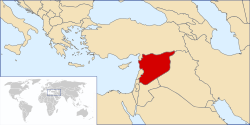Creating A Syrian Swamp: Assad’s ‘Plan B’ – OpEd
By Syria Comment - Joshua Landis
s the regime’s “end game” coming soon? I fear not. Assad is likely to treat Syria as he did Iraq and Lebanon: he will work to break them apart. In 2005, a friend who was close to the regime told me that Assad and those around him were convinced that they could defeat President Bush’s attempts to change the regime in Syria. They said:
Bush thinks he can use Iraq against us. But Iraq is not a nation. We will help turn its factions against the US. It will turn into a swamp and suck the US in. This is what we did to Israel and the US in Lebanon in the 1980s.
Today, Assad will treat Syria as he did Lebanon and Iraq earlier. He will gamble that it is not a nation and will work to tear it apart. Already he has withdrawn from the Kurdish parts of Syria. Friends in Aleppo tell me that Assad is arming the Kurds there. He will arm the Arab tribes in the hope that they will resist central control. I am told that a number of the tribes of Aleppo gathered to condemn the Free Syrian Army following the killing of a leader of the al-Berri tribe, Ali Zeineddin al-Berri, also known as Zeno, who was accused of leading a pro-regime shabiha militia group. Assad will arm those that fear the Free Syrian Army, such as the Aleppo tribes, which he has used to police Aleppo. As Damascus and Aleppo slip out of his control, he may well try to destroy them sooner than allow them to fall intact to the Free Syrian Army. Anyone who has ruled Syria knows that Damascus is its linchpin. By reducing it to ruins, Syria may become ungovernable. He will building up the rural groups that have chafed under Damascus’ control.

In order to survive, Assad and his Alawite generals will struggle to turn Syria into Lebanon – a fractured nation, where no one community can rule. He may lose Syria, but could still remain a player, and his Alawite minority will not be destroyed. Today, Junblatt, Geagea, Gemayyal, Franjia and other warlords are respected members of parliament and society. All might have been taken to the international court and charged with crimes against humanity two decades ago. After all, somewhere between 100,000 to 150,000 Lebanese were killed out of a population of three million during the civil war. When the Lebanese came to terms with the fact that no one camp could impose its rule over the others, they had no choice but to bury the hatchet and move forward.
If Assad surrenders, hundreds of regime leaders will be executed or tried for crimes against their fellow countrymen. The broader Alawite community fears the possibility of aimless retribution. To avoid this, Assad is likely to pursue the Lebanon option: turn Syria into a swamp and create chaos out of Syria’s sects and factions. It is a strategy of playing upon divisions to sow chaos. Already the Syrian Army has largely been transformed into an Alawite militia. If Assad must withdraw from Damascus, he will have nowhere to fall back on but Latakia and the coastal mountains. I have argued that the Alawite region cannot be turned into an independent state, but it does provide Assad and the remnants of the Syrian Army a social base. Just as Lebanon’s Maronites did not create an independent state in the Lebanon Mountains, they did use it to deny Muslim forces undivided supremacy over Lebanon. The Syrian opposition will have difficulty defeating Assad’s army. This is certainly true if opposition forces remain as fragmented as they are today. Assad is gambling on his enemies being unable to unite. He is working assiduously to turn Syria into a swamp in order to save what he can of his power and the lives of those around him.
If Assad is successful in this ambition, there will be no clear endgame to the fighting in Syria. Syria’s Baathist regime cannot survive. It is already collapsing. Most state institutions are no longer functioning. Order has broken down in many parts of the country. New authorities are springing up as the old disappear. But Assad’s army in its transformed state is likely to remain a powerful force. It is difficult to see how a clear winner will emerge in Syria. A new national pact will have to be hammered out between the forces on the ground. But those forces are only just beginning to take shape in their new forms today.

Factions,fractures; which is in worse shape? Assad or the “Free Syria” lackeys of the “West”.
Fact is the various ethnics and/or tribes will now have to settle their differences; outsiders ought to clear off while they do so.
Why don’t we just allow the Syrians to fight and kill each other? Let’s not interfere with their problems. Maybe Assad will get tired fighting his enemies, and decide ultimately to meet with his opponents to resolve their problems amicably as Syrians. Plus, is there a way the U.N. security council can help in the Syrian conflict?